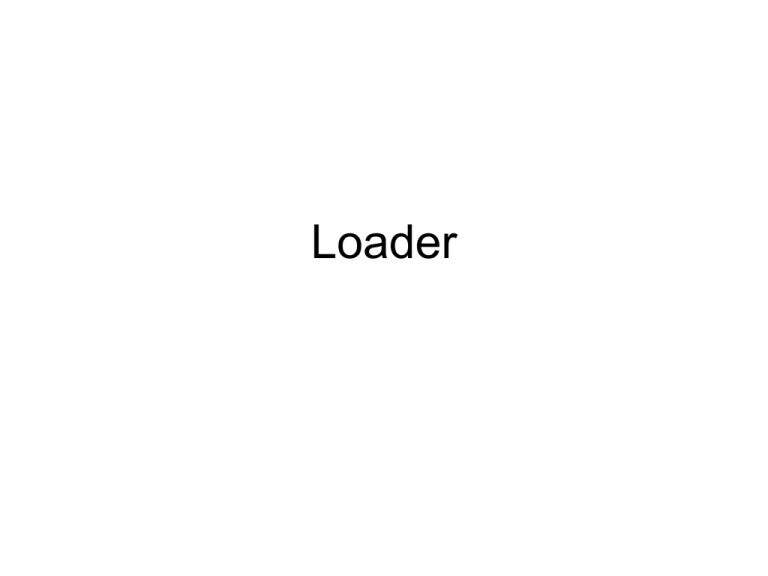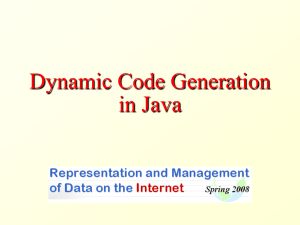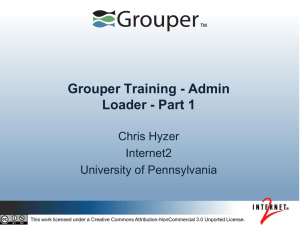Loader
advertisement

Loader
Role of Loader
Source
Program
Translator
Object
Program
Loader
Object
program
ready for
execution
Translator – Assembler/Compiler
Memory
Role of Loader and Linker
Memory
Source
Program
Assembler
Object
Linker
Program
Executable
Code
Loader
Object
program
ready for
execution
• Loader is a system s/w that makes a program ready for execution, by
copying the file from secondary memory to main memory for execution.
•It is usually part of Operating system.
•The main task of the loader is to bring binary executable image into main
memory and bind the relocatable addresses into absolute addresses.
•The binary image of a program consists of following parts :•Header – it shows the type of file (executable or library file)
•Text – it shows the actual code of the program
•List of shared libraries - libraries that have been used in the object
file
•
Design of The absolute loader –
An absolute object file consists of three part1) The start address of the program
2) The object instructions
3) The address of the first executable instruction. This is placed in the
object file by assembler in response to the END directive. It is either the
address specified by the END or, in the absence of such an address is
identical to the first address of the program.
The loader reads the first item and loads the rest of object file into
successive memory locations.
Algorithm for absolute loader:-
Begin
Read Header record
Verify program name and length
Read first text record
While record type is not ‘E’ do
begin
if object code is in character form
{
convert into internal representation
}
read next object program record
end
Jump to the address specified in End Record
end
Role of Absolute Loader
Object
Program
1000
Absolute
Loader
Object
program
ready for
execution
2000
Memory
Object Program
H COPY 001000 00107A
T 001000 1E 141033 482039 001036 281030 301015 482061 ...
T 00101E 15 0C1036 482061 081044 4C0000 454F46 000003 000000
T 002039 1E 041030 001030 E0205D 30203F D8205D 281030 …
T 002057 1C 101036 4C0000 F1 001000 041030 E02079 302064 …
T 002073 07 382064 4C0000 05
E 001000
Absolute Loader
•Advantage
- Simple and efficient
•Disadvantage
- the need for programmer to specify the
actual address
- difficult to use subroutine libraries
Bootstrap Loader
A Simple Bootstrap Loader
•When a computer is first tuned on or restarted, a special
type of absolute loader, called bootstrap loader is
executed
•This bootstrap loads the first program to be run by the
computer -- usually an operating system
•It is permanently stored in ROM. So it can not be erased.
Example (SIC bootstrap loader)
•The bootstrap itself begins at address 0
•It loads the OS at starting address 0x80
•No header record or control information,
the object code is consecutive bytes of
memory
After load the OS, the control is transferred to the
instruction at address 80.
Algorithm of bootstrap loader
Begin
X=0x80 (the address of the next memory location to be
loaded)
Loop
AGETC (and convert it from the ASCII character
code to the value of the hexadecimal digit)
save the value in the high-order 4 bits of S
AGETC
combine the value to form one byte A (A+S)
store the value (in A) to the address in register X
XX+1
End
GETC reads one character and convert it into hexadecimal
digit. For example, the ASCII code for ‘1’ through ‘9’ are
converted to the numeric values 1 through 9. and codes for
‘A’ through ‘F’ ( 41 to 46 Hex) are converted to the values 10
through 15. this is accomplished by subtracting 48 ( 30 in
Hex) from the character codes of 0-9 and by subtracting 55
(37 in Hex) from the codes of A-F
ASCII value of
0~9 : 0x30~39
A~F : 0x41~46
Machine Dependent Loader
Features
• Relocation
• Program Linking
Example of Relocation
Line
5
10
12
13
15
20
25
30
35
40
45
50
55
60
65
70
80
95
100
105
Loc
0000
0000
0003
0006
000A
000D
0010
0013
0017
001A
001D
0020
0023
0026
002A
002D
0030
0033
0036
Source statement
COPY
START
FIRST
STL
LDB
BASE
CLOOP +JSUB
LDA
COMP
JEQ
+JSUB
J
ENDFIL LDA
STA
LDA
STA
+JSUB
J
EOF
BYTE
RETADR RESW
LENGTH RESW
BUFFER RESB
Object code
0
RETADR
#LENGTH
LENGTH
RDREC
LENGTH
#0
ENDFIL
WRREC
CLOOP
EOF
BUFFER
#3
LENGTH
WRREC
@RETADR
C’EOF’
1
1
4096
17202D
69202D
4B101036
032026
290000
332007
4B10105D
3F2FEC
032010
0F2016
010003
0F200D
4B10105D
3E2003
454F46
125 1036 RDREC CLEAR X
130
132
133
135
140
145
150
155
160
165
170
175
180
185
210 105D WRREC CLEAR X
212
215
220
225
230
235
...(omitted)
B410
B410
Instructions at line no 15,35 & 65 are the only items whose values are
affected by relocation.
We use modification records for the relocation purpose.
Each modification record specifies the starting address and the length
of the field whose value to be altered. It then describes the modification
to be performed.
Modification record
col 1: M
col 2-7: relocation address
col 8-9: length (halfbyte)
col 10: flag (+/-)
col 11-17: segment name
Modification Record
HCOPY 000000 001077
T000000 1D17202D69202D48101036…4B105D3F2FEC032010
T00001D130F20160100030F200D4B10105D3E2003454F46
T001035 1DB410B400B44075101000…33200857C003B850
T0010531D3B2FEA1340004F0000F1..53C003DF2008B850
T00070073B2FEF4F000005
M00000705+COPY
M00001405+COPY
M00002705+COPY
E000000
Begin
Relocation Loader Algorithm
Get PROGADDR from OS
While not end of input do
{
read next record
while record type != ‘E’ do
{
read next input record
while record type = ‘T’ do
{
move object code from record to location
ADDR + specified address
}
while record type = ‘M’
add PROGADDR at the location PROGADDR +
specified address
}
}
end
Modification record scheme is not well suited for use with all machine
architectures and if many instructions require relocation then the number of
modification record will be very large.
To solve this problem we can use relocation bit method.
If the relocation bit corresponding to a word of object code is set to 1, the
program’s starting address is to be added to this word when the program is
relocated.
Relocation bit
- 0: no modification is necessary
- 1: modification is needed
Twelve-bit mask is used in each Text record
Since each text record contains < 12 words
Unused words are set to 0
Text record format
Text record
col 1: T
col 2-7: starting address
col 8-9: length (byte)
col 10-12: relocation bits
col 13-72: object code
Relocatable Program for SIC
Line Loc
5
10
15
20
25
30
35
40
45
50
55
60
65
70
75
80
85
90
95
100
105
0000
0000
0003
0006
0009
000C
000F
0012
0015
0018
001B
001E
0021
0024
0027
002A
002D
0030
0033
0036
0039
Source statement
COPY
FIRST
CLOOP
ENDFIL
EOF
THREE
ZERO
RETADR
LENGTH
BUFFER
START
STL
JSUB
LDA
COMP
JEQ
JSUB
J
LDA
STA
LDA
STA
JSUB
LDL
RSUB
BYTE
WORD
WORD
RESW
RESW
RESB
0
RETADR
RDREC
LENGTH
ZERO
ENDFIL
WRREC
CLOOP
EOF
BUFFER
THREE
LENGTH
WRREC
RETADR
C’EOF’
3
0
1
1
4096
Object code
140033
481039
000036
280030
300015
481061
3C0003
00002A
0C0039
00002D
0C0036
481061
080033
4C0000
454F46
000003
000000
125
130
135
140
145
150
155
160
165
170
175
180
185
190
210
215
220
225
230
235
240
245
250
255
1039
103C
103F
1042
1045
1048
104B
104E
1051
1054
1057
105A
105D
105E
1061
1064
1067
106A
106D
1070
1073
1076
1079
RDREC LDX
LDA
RLOOP TD
JEQ
RD
COMP
JEQ
STCH
TIX
JLT
EXIT STX
RSUB
INPUT BYTE
MAXLEN WORD
WRREC LDX
WLOOP TD
JEQ
LDCH
WD
TIX
JLT
RSUB
OUTPUT BYTE
END
ZERO
ZERO
INPUT
RLOOP
INPUT
ZERO
EXIT
BUFFER,X
MAXLEN
RLOOP
LENGTH
X’F1’
4096
ZERO
OUTPUT
WLOOP
BUFFER,X
OUTPUT
LENGTH
WLOOP
X’05’
FIRST
040030
000030
E0105D
30103D
D8105D
280030
301057
548039
2C105E
38103F
100036
4C0000
F1
001000
040030
E01079
301064
508039
DC1079
2C0036
381064
4C0000
05
Relocation by Bit Mask
H COPY 000000 00107A
T 000000 1E FFC 140033 481039 000036 280030 300015 481061 ...
T 00001E 15 E00 0C0036 481061 080044 4C0000 454F46 000003 …
T 001039 1E FFC 040030 000030 E0105D 30103F D8105D …
T 001057 1C 800 100036 4C0000 F1 001000
T 001061 19 FE0 040030 E01079 301064 508039 DC1079 2C0036 …
E 000000
Here the bit mask FFC (representing the bit string 111111111100)
In the first text record specifies that all 10 words of object code are to
be modified during relocation. Similarly bit mask E00 represents
that the first 3 words are to be modified .
Machine Independent Loader
Features
• Automatic library search
• Loader options
Automatic library search :This feature allows a programmer to use standard subroutines
without explicitly including them in the program to be loaded. So
programmer can use any subroutine by just mentioning their
names. The subroutines are automatically fetched from the library,
linked with the main program and loaded.
Loader maintains an External Symbol Table (ESTAB) for these
external symbols. The loader searches the library specified for
routines that contain the definitions of these symbols, and process
the subroutines found by this search.
In most cases a special file structure is used for libraries. This
structure contains a directory that gives the name of each routine
and a pointer to its address within the file.
Name Pointer
Loader Options :Many loader allow user to specify options that modify the
standard processing. Loaders have a special command
language that is used to specify the options.
Options:1) INCLUDE
2) DELETE
3) CHANGE
4) LIBRARY
1) INCLUDE:- this loader option allows the selection of alternative
sources of input. For example, the command
INCLUDE program-name (library name)
Might direct the loader to read the designated object program from a
library and treat it as the primary loader input.
2) DELETE:- it allows the user to delete external symbols or entire control
sections. For example, the command
DELETE csect-name
might instruct the loader to delete the name control section from the set of
programs being loaded.
3) CHANGE :- it allows the user to change name1 to name 2 in the
program. For example
CHAMGE name1 , name 2
Might cause the external symbol name1 to be changed to name 2
wherever it appears in the object programs
Example of Relocation
Line
5
10
12
13
15
30
35
40
65
70
105
Loc
0000
Source statement
COPY
START
0
0006
CLOOP
+JSUB
RDREC
4B101036
0013
+JSUB
WRREC
4B10105D
0026
+JSUB
WRREC
4B10105D
125
130
180
185
210
212
230
235
1036
RDREC
Object code
CLEAR X B410
INCLUDE READ(ULIB)
INCLUDE WRITE(ULIB)
105D
WRREC
CLEAR X B410
DELETE RDREC,WRREC
CHANGE RDREC, READ
...(omitted)
CHANGE WRREC, WRITE
These command would direct the loader to include control sections
READ & WRITE from the library ULIB, and to delete the control
sections RDREC and WRREC from the load.
The first CHANGE command would cause all external references to
symbol RDREC to be changed to refer to symbol.






